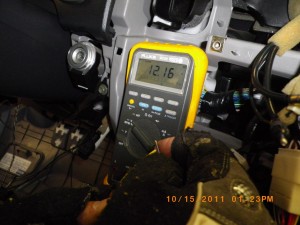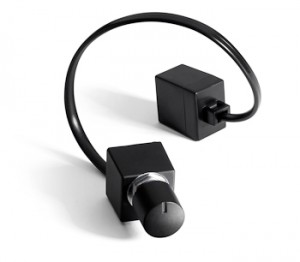Want to know how to hook up an amp and sub to a stock stereo?
Wiring up an amplifier to a stock radio is something that many of our customers do themselves. With the proper parts and correct wiring, this can be an easy way to improve your factory stereo system.

The first thing you will need, if you don’t already have it, is a line output converter. We carry the PAC Audio LP7-2. This is what is going to feed signal into your amplifier. Factory radios don’t have pre amp outputs, this adapter will convert factory speaker wire into a preamp output. These line output converters, also known as hi to low level converters, are typically wired into the rear speaker wires of a vehicle. This will provide audio signal to your amp. It is very important to get the phase of the wiring correct. If you just tap into a pair of speaker wires and happen to get some sound, you may not necessarily have positive and negative correct. If you were to get the right rear speaker positive and negative correct, but the left rear speaker positive and negative reversed, you will have effectively canceled out your bass frequencies.
Check the phase
 The factory speaker wires will not be labeled and will not be marked like typical aftermarket wiring harnesses. You will need a multimeter and a double AA battery with some speaker wire hooked up to it in order to test for for speaker wires and the phase. To make your speaker wire tester, simply take some speaker wire and electrical tape the positive wire to the positive post and the negative wire to the negative end of the battery. Speaker wires tend to be grouped together, so look for what may be pairs to start testing. You will want to make sure you are not sending power to any wires other than speaker wires, so that is where your multimeter comes in handy.
The factory speaker wires will not be labeled and will not be marked like typical aftermarket wiring harnesses. You will need a multimeter and a double AA battery with some speaker wire hooked up to it in order to test for for speaker wires and the phase. To make your speaker wire tester, simply take some speaker wire and electrical tape the positive wire to the positive post and the negative wire to the negative end of the battery. Speaker wires tend to be grouped together, so look for what may be pairs to start testing. You will want to make sure you are not sending power to any wires other than speaker wires, so that is where your multimeter comes in handy.

In most cases, you will want to wire the line output converter in behind the stereo. This is a good idea if you ever plan on changing the stereo as your RCAs will already be ran. After removing the radio, using your meter, check for power, ground and accessory wires. Once you know what is not speaker wires, you can start testing pairs of wires.
Strip back a little bit of the wire and hook each end of the battery tester up to a pair of wires. If you have a pair of speaker wires, you will hear the speaker popping or scratching. Once you hear sound, you need someone else to actually look at the speaker. If the speaker is moving in and out, you have positive and negative correct. If the speaker is sucking back in, you have positive and negative reversed.
Once you have determined the proper speaker wires for the rear speakers, you can tap into them and hook them up to the line output converter.
How to connect the remote turn on lead
Now that you have your speaker wires figured out, we can move on to the remote turn on lead. If you use the PAC LP7-2 with signal sensing remote turn on, the line output convertor itself will give you a remote turn on lead. This is not a standard feature of all line output convertors, so depending on which one you use, you may still need to find an accessory power source in the vehicle. If you were testing all of your wires earlier with a multimeter, you should know which wire is a switched power source. That would be the proper place to wire in the remote turn on lead. You do not want the amp wired up to constant power as this will drain your car battery.
Buy a dedicated bass knob
One down side to wiring in an amplifier to a stock radio is that most stock stereos are self adjusting, meaning as you turn the volume up on the stereo, internally the stereo is usually keeping the bass level and the same in comparison to other frequencies. They do this to prevent you from blowing up the stock speakers. This can be pretty frustrating as it means your subwoofer level may stay the same regardless of you turning up the volume knob on the stereo.

One way around this is to also wire in a subwoofer control knob. I particularly like the JL Audio CL-RLC as it is not only a subwoofer control knob, but also a line driver. Line drivers boost the signal from the stereo which can give you a lot more output. Now that you have your signal and remote turn on figured out, the rest is a pretty standard amp installation.
If you are adding an amp and sub to an already amplified factory system, you need to wire your amp in a little differently. If you have a premium factory radio, that has it’s own amplifier, check to see if there is a factory subwoofer. If you are adding an amp and sub to a factory premium sound system with it’s own stock subwoofer, you must get your signal for the line output converter from that subwoofer. If you do not, you will not get any bass output. The reason for this is the stock amplifier will be crossed over at a certain frequency.
When there is a stock amplifier in a car, it is filtering what frequencies get played through what speakers. If this is the case and you wire in your line output converter to the rear door speakers, you may only be getting frequencies of 80 hz and up, not exactly what you’re looking for when it comes to bass. So be certain you get your signal from the stock subwoofer if your vehicle comes equipped with one.
Another problem you may encounter when wiring an amp and sub into a premium factory sound system is the signal level may be too high or too low. You may have to get your signal before or after the amplifier; every car is different and you just need to try it to really see what will work best for your vehicle and application.
Adding an amp and subwoofer to a stock radio can be the easiest way to improve your stereo system in your car, if you do it correctly.